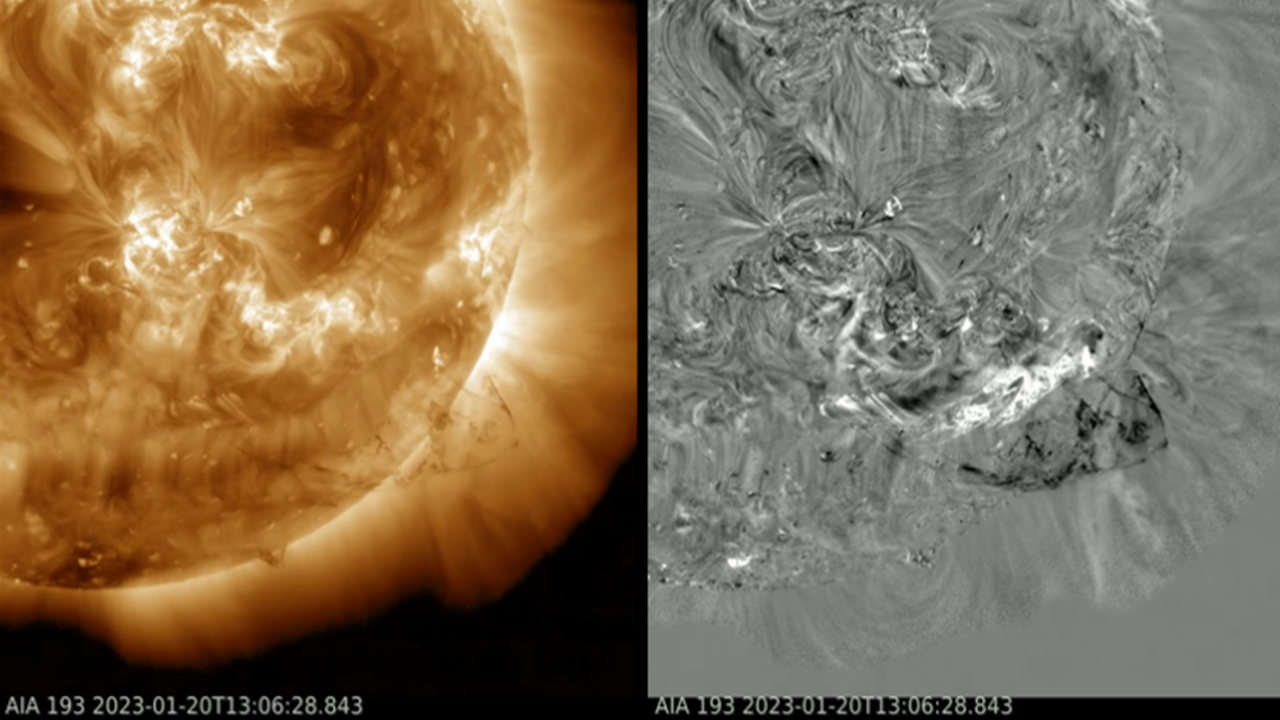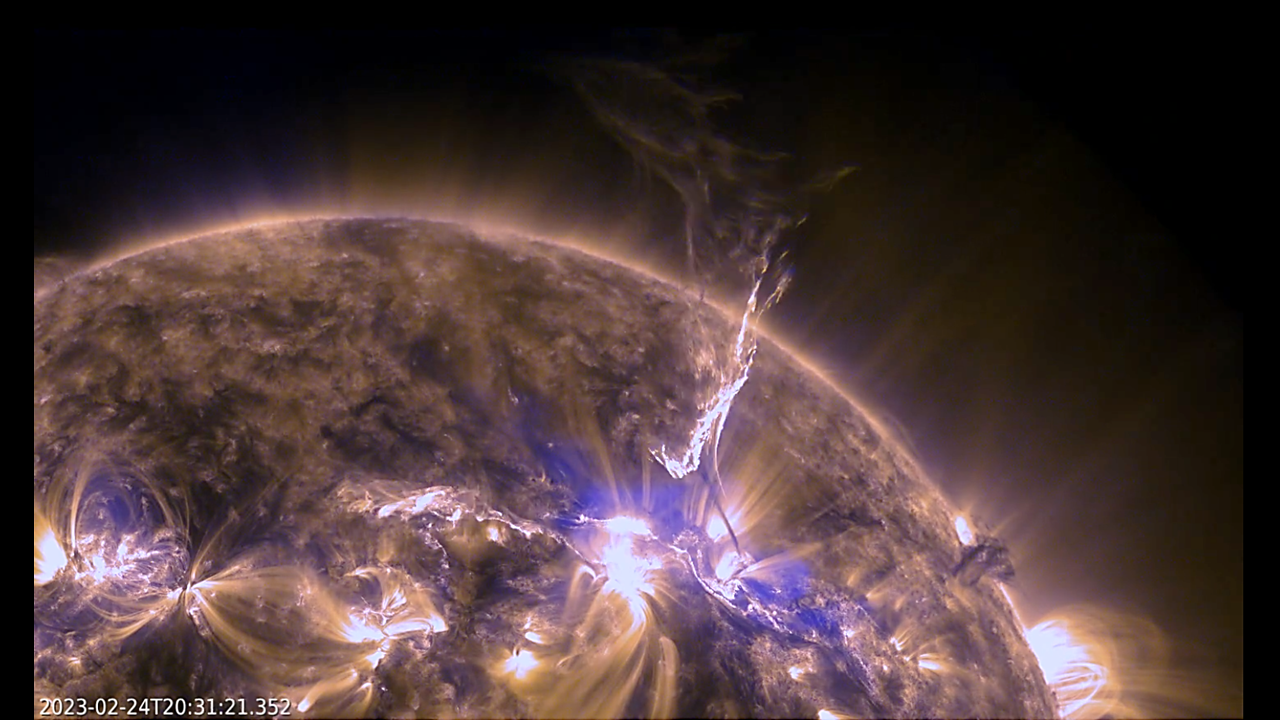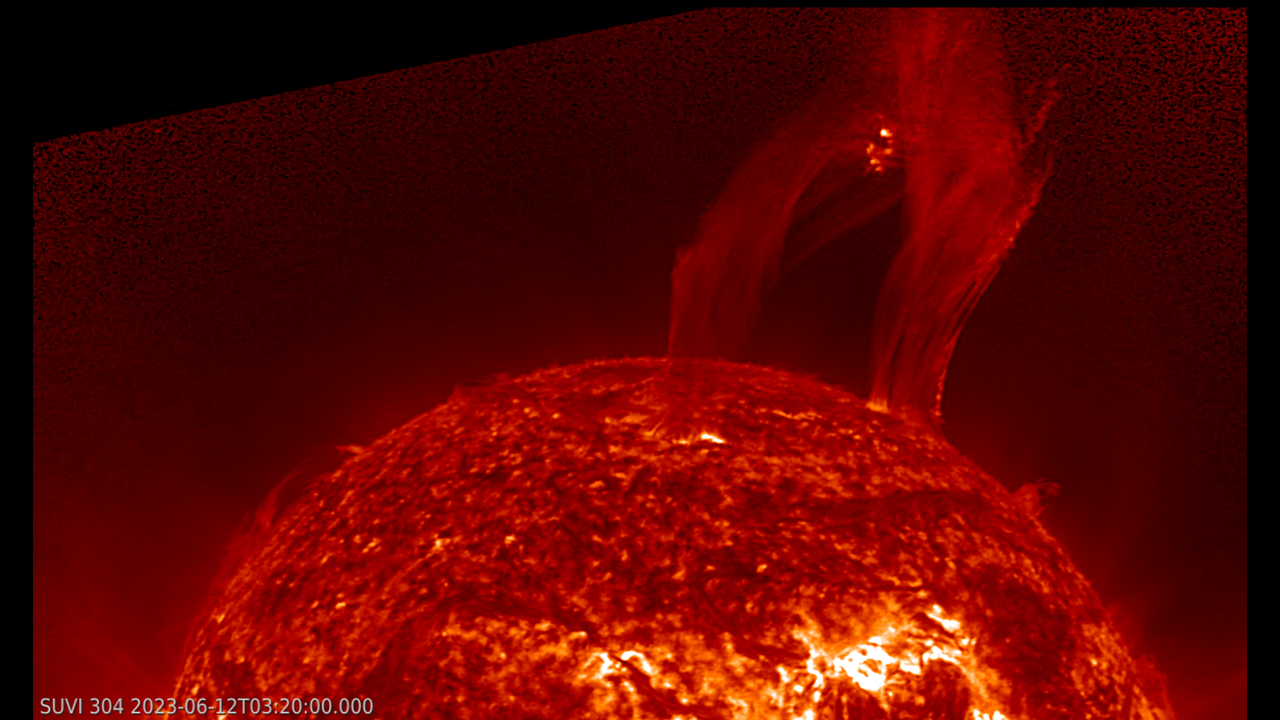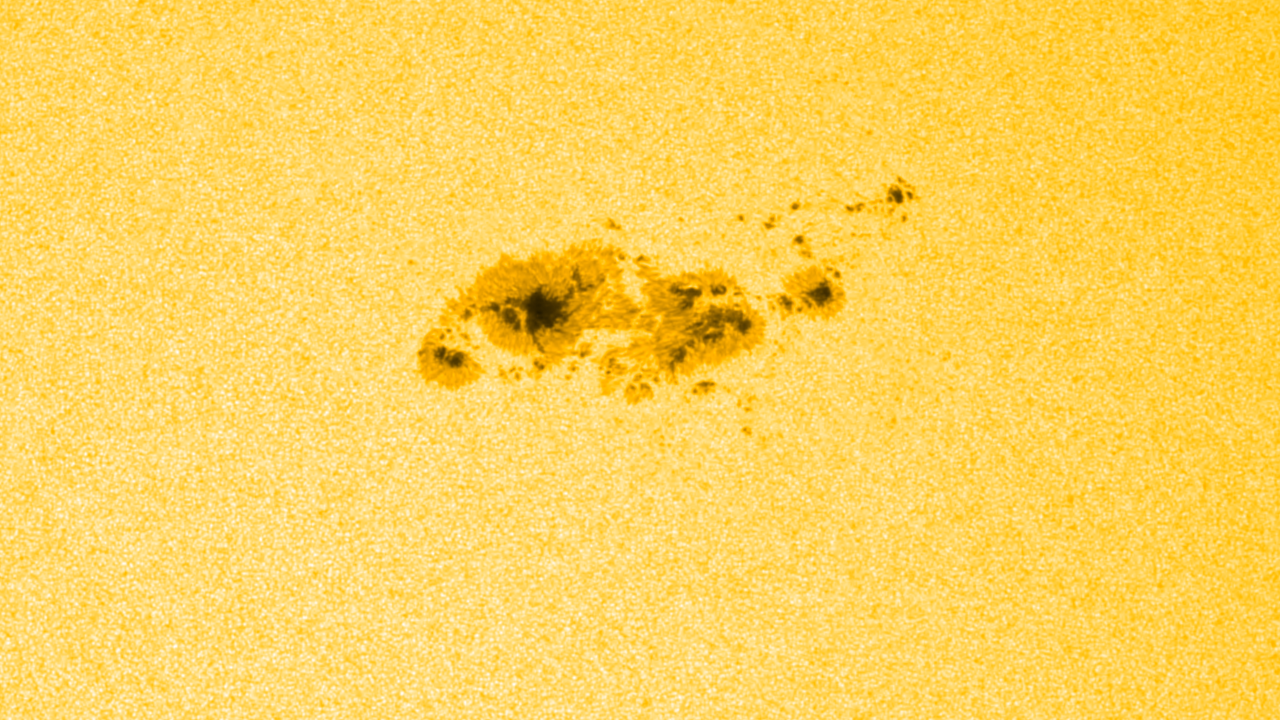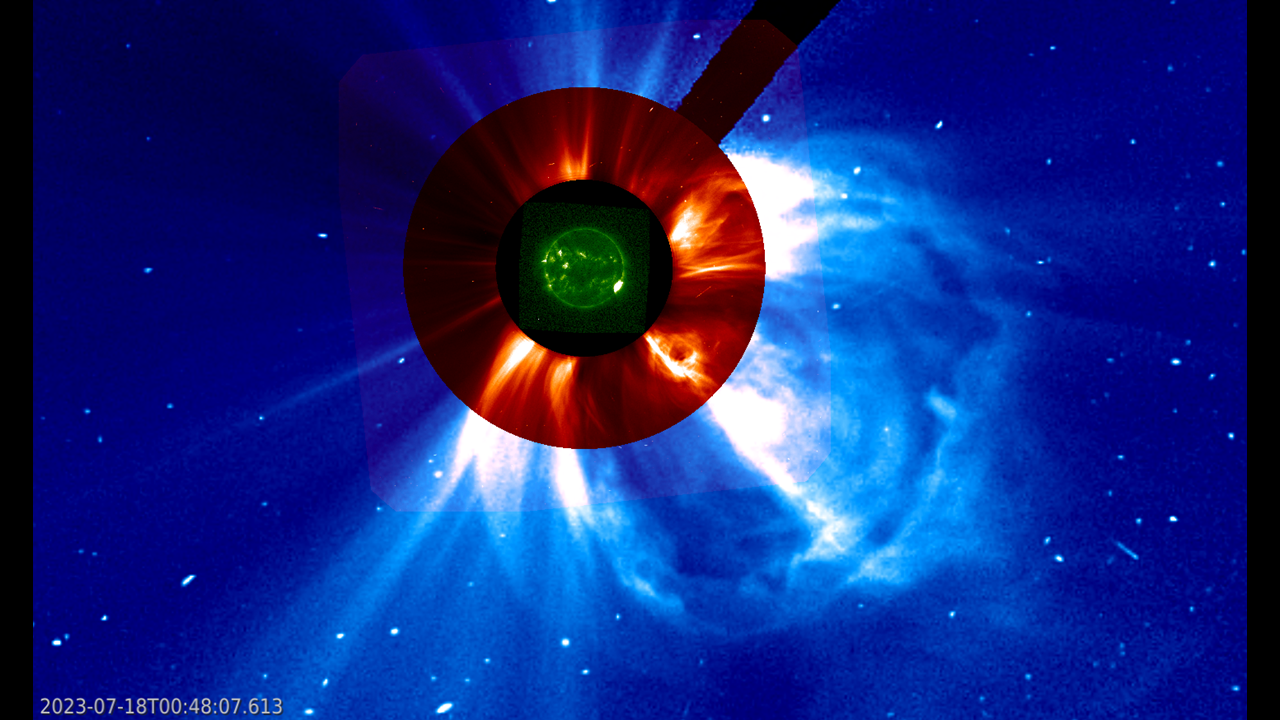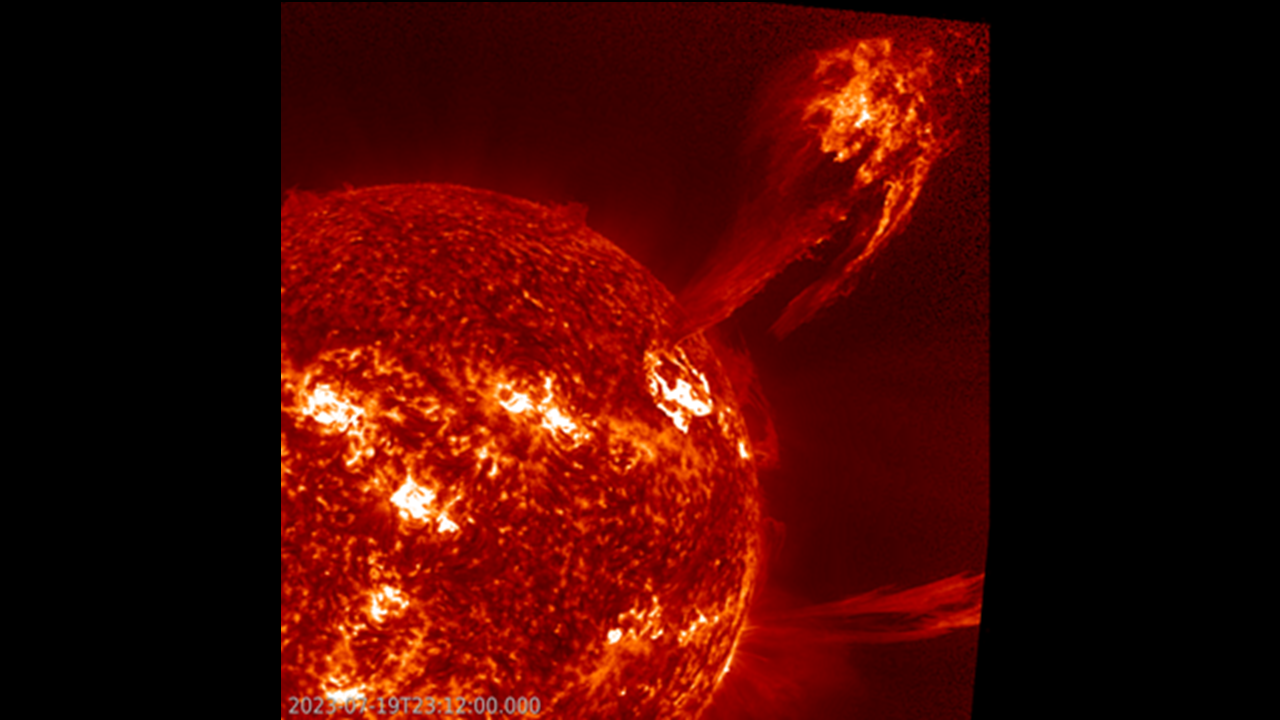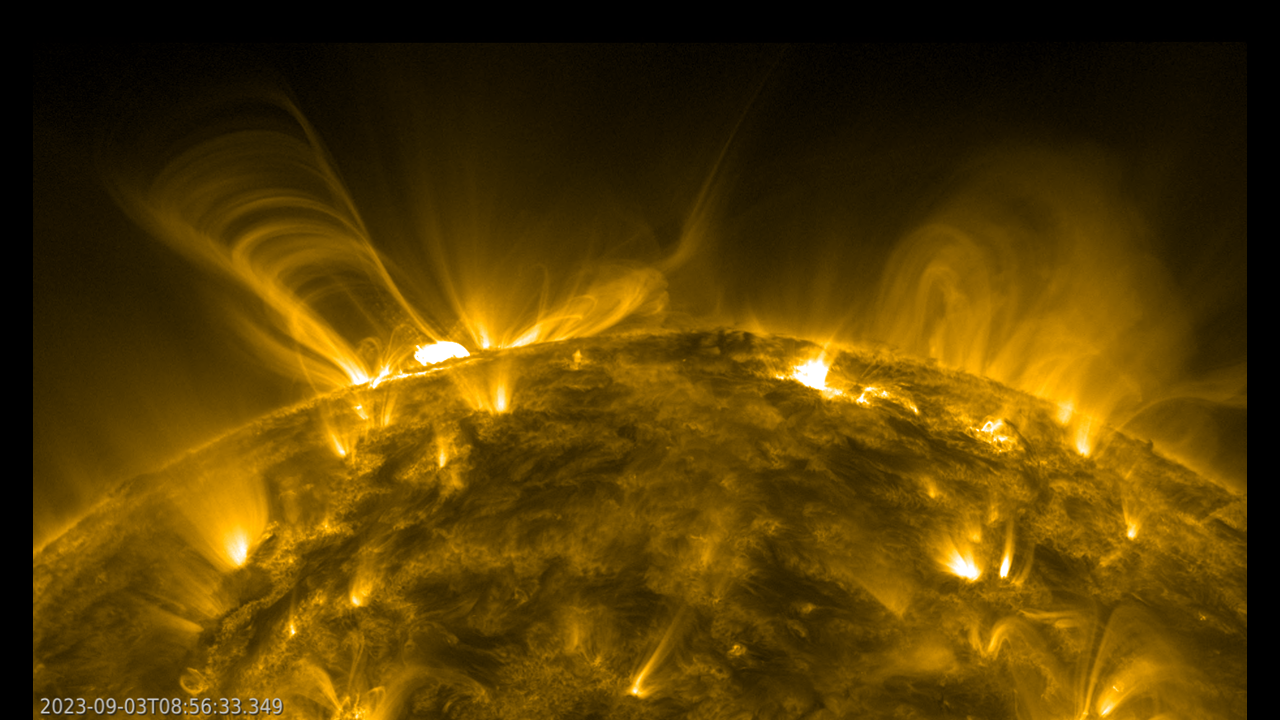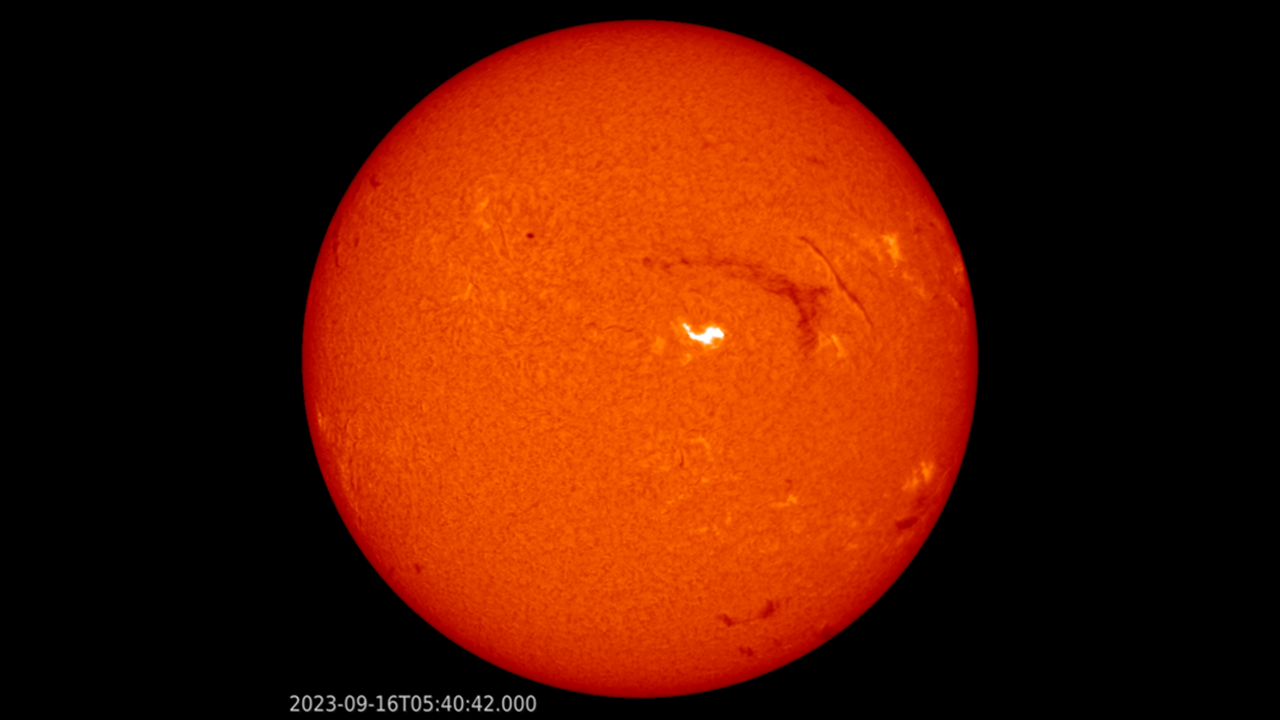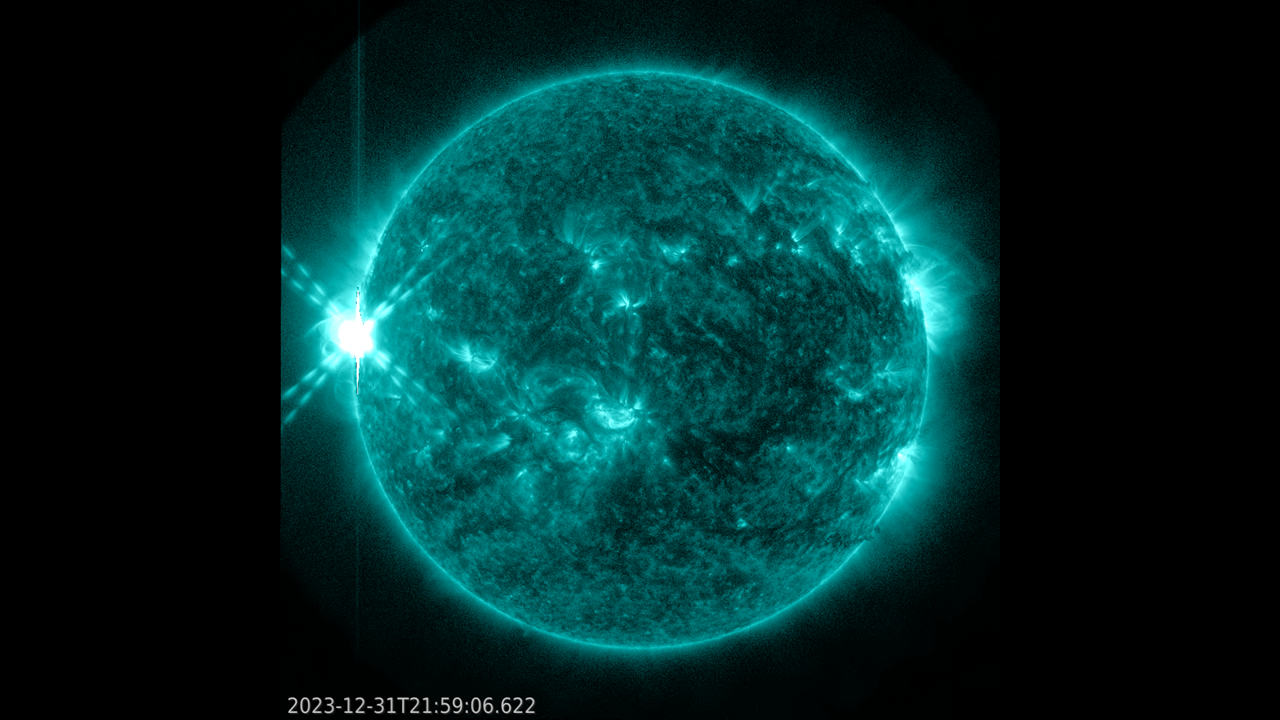A compilation of the most memorable space weather moments of 2023 can be found underneath. Using the versatile Space Weather JHelioviewer (SWHV - http://swhv.oma.be/user_manual/) software, a ***MOVIE*** was created (available on YouTube ) containing one or more clips of each event. Usually, images from SDO, GOES/SUVI, STEREO, and SOHO have been used, occasionally supplemented with imagery from Solar Orbiter, PROBA2/SWAP, ROB/USET and the GONG/H-alpha network.
As this chronological list concerns mostly punctual events on the Sun, it does not contain clips from other noteworthy events in 2023 such as e.g. the total solar eclipse of 20 April, or the fly-by of STEREO-A on 12 August.
Happy viewing!
Event 1: 20 January - Filament eruption
An impressive filament, about as long as the Earth-Moon distance (!), erupted on 20 January. Solar Orbiter, trailing the Earth by about 27 degrees, also had a good view on the eruption. The associated coronal mass ejection (CME) had a plane-of-the-sky speed of 512 km/s and was directed towards the southwest. A weak disturbance in the solar wind parameters (DSCOVR) was recorded early on 23 January, but a definite link with the observed CME could not be established due to various other solar activity going on around 20 January.
Ref: STCE newsitem of 24 January
Event 2: 24-25 February - Double filament eruption
A filament near decaying sunspot group NOAA 13229, itself the source of an X-class event on 17 February, erupted twice on 24 and 25 February respectively. These eruptions were associated with long duration M3 and M6 flares (GOES soft x-ray), and the latter was also accompanied by the first proton event of 2023 (58 pfu on 26 February). Both were spectacular in extreme ultraviolet imagery, in particular the first eruption. Coronagraphic observations by SOHO/LASCO indicated two fast earth-directed halo CMEs with projected (plane-of-the-sky) speeds of resp. 950 and 1150 km/s. These CMEs arrived late on 26 and early on 27 Fenruary, creating a major geomagnetic storm (Kp = 7- ; Dst = -132 nT). Geostationary satellites were exposed to the solar wind, GNSS applications for aviation degraded over Europe, USA and Canada, and drilling operations were temporarily halted in Manitoba (Canada).
Strong geomagnetic storms were also observed on 23-24 March (-163 nT) and 23-24 April (-213 nT). The latter storm was the strongest of the year and the strongest so far during SC25. Aurora were photographed as far south as Texas and California in the United States, and from Slovenia and Southern Spain in Europe. The magnetic shielding provided by this strong interplanetary CME resulted in a significant decrease in the harmful cosmic rays of 6% as recorded by neutron monitors around the world (a so-called "Forbush decrease"), the strongest of the year.
Ref: STCE newsitem of 1 March
Event 3: 12 June - Polar filament eruption
A spectacular polar crown filament (PCF) eruption took place early on 12 June. These filaments are located at the highest latitudes, separating the predominant polar field of the previous cycle and the dispersed field of the current cycle, which is drifting poleward from the trailing polarities of sunspot groups at lower latitudes. The "old" polar magnetic field is currently still strong enough to keep the newly arriving opposite polarity field at bay, and where the two encounter each other, a solid filament can form. This also means that small changes in these magnetic fields may result in instabilities in and the subsequent eruption of (a portion of) the filament. This kind of activity indicates that the polar field reversal is still going on, and solar cycle maximum has not arrived yet.
Ref: STCE newsitem of 27 June
Event 4: June-July - Highest sunspot numbers, largest sunspot group
From 26 June onwards, a sunspot region quickly developed to become one of the largest sunspot groups of the current solar cycle (SC25) so far. NOAA 13354 reached an area 7 times the total surface area of the Earth, and -using eclipse glasses- was an easy naked eye object. The region produced an X1 flare on 2 July. SILSO indicated that both June and July reached sunspot numbers of 160, and the smoothed monthly sunspot number reached a (first) maximum in June (125.3). The daily sunspot number reached its highest value also during this period, on 22 June (240).
Ref: STCE newsitem of 3 July
Event 5: 18 July - Strongest proton event of the year
NOAA 13363, a large sunspot group that dominated the solar disk for the first 2 weeks of July, was the source of an M5.7 flare on 18 July. The greater than 10 MeV proton flux reached a maximum of 620 pfu, making it a moderate solar radiation storm (S2 on the NOAA scales), meaning that satellites may experience an occasional bit flip ("single event upset") and that high frequency (HF) communications may be affected over the polar areas (a so-called Polar cap Absorption"). This is by far the strongest proton event so far this solar cycle (SC25), and the first S2-level storm.
Ref: STCE newsitem of 18 July
Event 6: 19-20 July - Violent filament eruption near the northwest limb
One of the more impressive filament eruptions took place late on 19 July, when a rather short fragment violently erupted near the northwest solar limb. Despite being a small filament, the eruption was truly spectacular in extreme ultraviolet (EUV) imagery such as in GOES/SUVI 304 showing the Sun at temperatures near 80.000 degrees. Similar to the 1974 movie "The Towering Inferno", it looked like a skyscraper engulfed in flames, only -around 23:12UTC- to tower at least twice the Earth-Moon distance over the solar surface - that's a whopping 750.000 km! This pillar of fire could be tracked throughout SUVI's field of view.
Ref: STCE newsitem of 24 July
Event 7: 1 September - Some impressive M-class flares
NOAA 13413 was a unipolar sunspot group consisting of mainly positive magnetic polarity for most of its transit over the solar disk. Then, late on 28 August, the situation became more interesting with the gradual emergence of opposite magnetic polarity flux south and southwest of the main sunspot. The close proximity of these opposite magnetic polarity fluxes kicked off a series of 4 M-class flares, starting with a long-duration M1 flare peaking early on 1 September and ending with an M6 flare on 3 September. In 2023, there were sunspot groups that produced significantly more M-class flares than NOAA 13413. In May, NOAA 13311 produced no less than 25 M-class flares, a record for SC25 so far (no X-class though). Also, NOAA 13213 (16) and 13380 (15) showed their preference for these "medium" eruptions.
Ref: STCE newsitem of 6 September
Event 8: 16 September - Spectacular filament eruption
Early on 16 September a large filament near active region NOAA 13429 became unstable and erupted. The source of this instability might have been an M2 flare in the same active region a few hours earlier. This was a huge event, with one of the anchor points of the erupting located in the southern hemisphere near another active region (NOAA 13431). The interplanetary CME arrived at the earth environment on 18 September, sparking of a moderate geomagnetic storm (Kp = 6+ ; Dst index (Kyoto WDC): -85 nT). The local K-index for Belgium (K_BEL) reached only minor geomagnetic storm levels. Aurora were photographed in France, but in general their visibility remained restricted to the usual locations such as Scotland, Scandinavia, and along the Canada-United States border. The launch of an Electron rocket apparently got delayed by 20 minutes due to the adverse geomagnetic conditions (SpaceNews). A number of advisories were issued (PECASUS) for the benefit of the civil aviation, alerting for a depression of the maximum usable radio frequency (HF range, i.e. 3-30 MHz).
Ref: STCE newsitem of 19 September
Event 9: 27-29 November - A series of filament eruptions
A series of filament eruptions on 27 November and an M9.8 flare produced by NOAA 13500 on 28 November were associated with a series of CMEs, some of which had an earth-directed component. Solar wind parameters indicates only 2 obvious increases in the CME speed: one late on 30 November, when the wind speed increased from 350 km/s to 490 km/s, and a second abrupt increase on 1 December around 08:45UTC when the wind speed jumped from 410 to 530 km/s. The latter interplanetary CME was the strongest, with Bz - the north-south component of the interplanetary magnetic field - reaching -26 nT. This was likely the passage of the 28 November CME, with other solar wind parameters suggesting it had probably gobbled up one or 2 previous CMEs (a "cannibal" CME). A major geomagnetic storm was observed, the second in less than a month but also a bit less intense than the 5 November storm (-108 nT vs -172 nT). Together with the geomagnetic storms in February, March and April, these were the strongest storms of 2023.
Ref: STCE newsitem of 5 December
Event 10: 31 December - X5.0: strongest flare of the year
The Sun kept the 2 strongest flares of SC25 so far for the last 2 weeks of the year. NOAA 13514 was the source of an X2.8 flare that peaked on 14 December. It was associated with a strong radio burst, in particular at frequencies below 1GHz and lasting for more than an hour. Intensities around 900.000 sfu were reached at 410 and 610 MHz, and 600.000 sfu at 245 MHz. The "strong x-ray flare + strong radio burst" tandem caused severe high frequency communication (HF Com) problems in aviation. Multiple pilots and ground stations reported communication disruptions, with the impact felt across the entire United States of America (SWPC).
Two weeks later, after its farside transit, the same region -now known as NOAA 13536- produced an X5.0 on 31 December. This is the strongest solar flare since the X8.2 event on 10 September 2017 and the X9.3 flare from 6 September 2017. It was visible as a white light flare (WLF) in satellite imagery (SDO). The associated partial halo CME had a calculated speed around 2400 km/s, which is pretty rare, i.e. CMEs with such a speed are seen on the average only once every year.
Ref: STCE newsitems of 14 December, 31 December, and 3 January 2024

